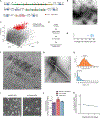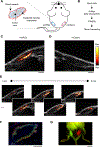Ultrasound imaging of gene expression in mammalian cells
- PMID: 31604277
- PMCID: PMC6860372
- DOI: 10.1126/science.aax4804
Ultrasound imaging of gene expression in mammalian cells
Abstract
The study of cellular processes occurring inside intact organisms requires methods to visualize cellular functions such as gene expression in deep tissues. Ultrasound is a widely used biomedical technology enabling noninvasive imaging with high spatial and temporal resolution. However, no genetically encoded molecular reporters are available to connect ultrasound contrast to gene expression in mammalian cells. To address this limitation, we introduce mammalian acoustic reporter genes. Starting with a gene cluster derived from bacteria, we engineered a eukaryotic genetic program whose introduction into mammalian cells results in the expression of intracellular air-filled protein nanostructures called gas vesicles, which produce ultrasound contrast. Mammalian acoustic reporter genes allow cells to be visualized at volumetric densities below 0.5% and permit high-resolution imaging of gene expression in living animals.
Copyright © 2019 The Authors, some rights reserved; exclusive licensee American Association for the Advancement of Science. No claim to original U.S. Government Works.
Conflict of interest statement
Figures




Comment in
-
A sound strategy for gene expression.Nat Rev Genet. 2019 Dec;20(12):703. doi: 10.1038/s41576-019-0181-8. Nat Rev Genet. 2019. PMID: 31578467 No abstract available.
-
Listening for Gene Expression.Radiol Imaging Cancer. 2019 Nov 29;1(2):e194008. doi: 10.1148/rycan.2019194008. eCollection 2019 Nov. Radiol Imaging Cancer. 2019. PMID: 33778686 Free PMC article. No abstract available.
References
-
- Tsien RY, Imagining imaging’s future. Nature Reviews Molecular Cell Biology 4, SS16–SS21 (2003). - PubMed
Publication types
MeSH terms
Substances
Grants and funding
LinkOut - more resources
Full Text Sources
Other Literature Sources
Research Materials

